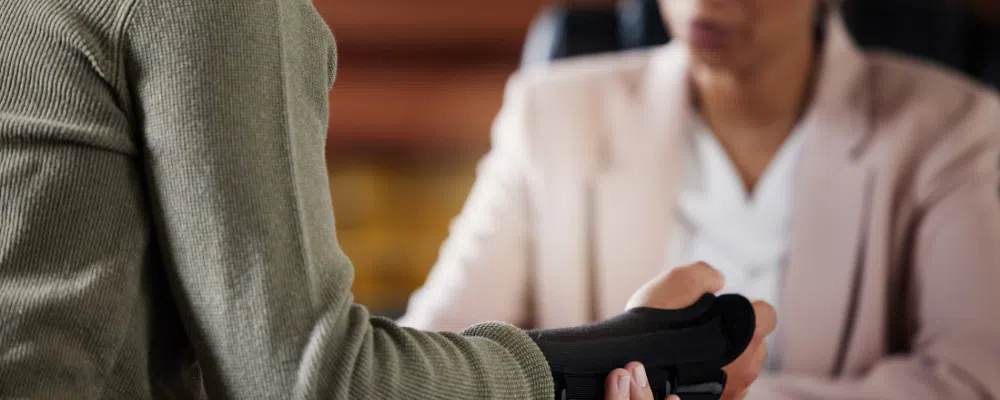The personal injury lawsuit process in Florida can be overwhelming when you are injured and unfamiliar with how the system works.
“An accident can set in motion a number of issues: Police reports, property damage claims, medical evaluations, and bills. And with the delay tactics by the insurance company, it’s enough to make your head spin. Of course, we handle it all for you, and you can rest assured that we’re determined to get you the compensation you deserve. Through it all, we never lose focus on what’s important: How it affects your life.” – Eddie Farah, Founding Partner
Our personal injury lawyers in Jacksonville and throughout Florida will always explain everything happening with your case. While every case is unique, our comprehensive guide can help you understand all the steps involved in a personal injury lawsuit.
Step 1: Hire a Reputable Personal Injury Lawyer
A knowledgeable injury lawyer is your greatest ally during the personal injury claims process. Insurance companies waste no time protecting their interests. They aim to avoid paying compensation or minimize it as much as possible. The responsible party’s insurance company will likely contact you within days of your accident. From the start, the insurance company may attempt to downplay your injuries and get you to admit fault for the accident.
Our personal injury lawyers in Orlando, Fort Myers, Tampa, and throughout Florida can deal with the insurance company and advise you on the best strategies to protect your claim. The sooner you involve an attorney, the fewer opportunities the insurance company will have to undermine your claim.
We offer a free initial consultation so you can ask us questions, and we can review your accident to determine whether you have grounds to file a lawsuit. If we accept your case, we will handle all of the steps in a personal injury lawsuit so you can focus on your recovery. Scheduling a free consultation is easy. Just call our Florida personal injury law firm at (877) 245-6707 from anywhere in Florida.
Step 2: Complete Your Medical Treatment
Medical records often provide the only documentation to prove your injuries and are necessary to calculate your case’s value. If you miss appointments, wait too long to seek treatment, or fail to finish treatment, the insurance company can downplay your injuries. Even if you have severe pain, disfigurement, and obvious disabilities, you won’t be able to prove it without documentation. Do the following to protect your claim:
- Report all symptoms to your doctor.
- Tell your doctor if your symptoms worsen.
- Attend all appointments and therapy sessions.
- Provide your medical and billing records to your attorney.
We understand the hardship of getting to the doctor and paying for care when you have disabling injuries. At Farah & Farah, we can help you find the care you need and arrange transportation to the doctor while your case works through the system.
Step 3: File an Insurance Claim
Before filing a lawsuit, you must file a claim with the responsible party’s insurance company. If you were injured in a traffic accident, you must file a claim with your own insurer under your no-fault coverage, regardless of who was at fault. If you have sustained severe injuries, you can file a claim under the other driver’s liability insurance.
An attorney can determine who is responsible for your injuries and which insurance claims you should file. In some cases, your attorney may identify more than one liable party. Your attorney will also send a letter of representation to inform the insurance company that you have an attorney. This letter puts the insurance company on notice that its representatives should contact your attorney instead of you.
The Demand Letter
Once your case investigation is completed, your attorney will typically send the insurance company a demand letter. The demand letter will detail the legal basis for your claim and state how much compensation you require to be made whole for your injuries. If the insurance pays the demand in full, your attorney will likely advise you to accept the payment and settle your claim. If the insurance company refuses to pay, you may need to file a lawsuit.
Step 4: Gather Evidence
As the plaintiff in a potential lawsuit, you will need evidence to prove that the defendant caused or contributed to your injuries. Evidence in a personal injury claim may include the following and more, depending on the type of accident:
- Eyewitness testimony
- Video footage
- Photographs of the scene.
- Forensic evidence
- Inspection records
- Driver logs
- Toxicology reports
- Medical records
- Defective product information.
- Expert witness testimony.
If you took pictures of the accident scene, exchanged contact information with eyewitnesses, or gathered any other information, provide all of it to your attorney as soon as possible.
At Farah & Farah, we will do the hard work for you. We will visit the accident site, download vehicle black box data, interview witnesses, research product recalls, and do whatever work is needed to gather the evidence and build a compelling case.
We also work with respected vehicle accident reconstructionists, private investigators, medical experts, and other consultants in our network to build a mountain of evidence to meet your burden of proof, clear you of any blame wrongfully assigned to you, and convince a jury of the defendant’s liability.
Step 5: Negotiate a Settlement
Settlement negotiations may begin within days of your accident and continue throughout your personal injury litigation until you reach a settlement or receive a verdict. It is important not to accept a settlement offer prematurely. It takes time to fully understand the lifetime costs of your injuries and if you settle too soon, you may discover too late that your injuries are going to cost more than you anticipated.
Insurance companies often make early settlement offers. However, these are usually lowballed offers that fail to account for your long-term costs. If you accept an offer too soon, you won’t be able to ask for more money later if you need it. Insurance companies know that severe injuries put you in a bad position financially, and they hope you will accept a low settlement out of desperation.
Our attorneys at Farah & Farah have worked with thousands who have faced the aftermath of devastating accidents. We understand you need money as soon as possible and are here to help you navigate the options. Our clients are often surprised when we find insurance policies they didn’t know they had, such as employer-based disability compensation and umbrella policies.
Step 6: File a Lawsuit
If the insurance companies and liable parties fail to pay your full claim value and you don’t reach a settlement within a reasonable time, the next step is to file a personal injury lawsuit. You don’t want to wait too long to file suit. Florida’s personal injury statute of limitations requires most lawsuits to be filed within two years of the incident.
Once you file your lawsuit, a process server will provide the defendants with a copy of the lawsuit in person. The defendants generally have 20 days from the service of process to file an answer. In the answer, the defendants will typically deny responsibility for your injuries. A trial date will be set, but settlement negotiations will typically continue.
You must complete the case investigation before filing the lawsuit. Once you file your lawsuit, the discovery process begins, and the defendants will be entitled to view your evidence. You’ll want the evidence to be strong enough to convince a jury of the defendants’ liability or persuade the defendants to settle.
Step 7: Complete the Discovery Process
During the discovery process, the parties on both sides of the lawsuit exchange information. You have a right to compel the defendants to provide certain types of evidence that may help prove your case, such as the following:
- Product recall information.
- Safety inspection records.
- Driver logs in big truck accident cases.
- Toxicology reports in automobile accident cases.
- Any other evidence relevant to your claim.
The defendants can also require you to provide access to your information, such as your medical records.
If your evidence is strong, settlement negotiations may become more effective after completing the discovery process. Insurance companies know a winning case when they see one, and they also know that losing in court can cost them more than paying the settlement you deserve. Many will settle once they’ve had a chance to view your evidence.
Your attorney can generally handle the exchange of information for you. However, you may be required to testify in an informal hearing known as a deposition during discovery.
What To Expect During a Deposition
Depositions can be scheduled at any time during the discovery phase. During a deposition, the defendants can ask you questions about your claim in the presence of your attorney and a court reporter. Although the deposition is somewhat informal, your testimony will be under oath and can be used against you later at trial.
Depositions need not be scary. Your attorney will prepare you ahead of time so you can testify with confidence.
Step 8: Go to Trial
As the case proceeds to trial, there are four potential outcomes:
- The case is dismissed
- The case settles
- A jury or judge returns a verdict
- The jury is unable to render a verdict
The vast majority of personal injury claims never get to trial because they settle. Even after the trial begins, settlement negotiations can continue until a verdict is announced.
During the trial, your attorney will present your evidence to the court and, in the case of a jury trial, the jury. The trial will begin with both sides making opening statements. Your attorney will question witnesses, cross-examine the defendant’s witnesses, and object to any evidence the defendants attempt to present that is unnecessarily harmful to you. The defense will also have an opportunity to present its witnesses and cross-examine your witnesses. Both sides will make closing statements before the jury deliberates and announces a verdict.
Step 9: Settlement or Verdict
During deliberations, the jury reviews the evidence behind closed doors while you wait. Jury deliberations can range from a few hours to several days until the jury reaches a unanimous verdict. If the jury cannot reach a unanimous decision, the judge will declare a mistrial. In that case, you must resume settlement negotiations or initiate a new lawsuit and try the case again. This outcome is rare when the evidence is strong.
If the jury agrees that the defendant is liable, the verdict will also specify the percentage of fault that lies with you, if any. If there are multiple defendants, the jury will specify the percentage of fault assigned to each defendant. The jury will also decide the amount of damages the defendants must pay. Once the jury rules, its job is complete. The lawsuit is over unless a party appeals.
The Appeals Process
The verdict in most personal injury lawsuits is final. However, a party unhappy with the verdict may file a motion for a new trial under certain circumstances. They may also appeal if they believe the court made an error that affected the outcome.
To appeal a verdict, you or your attorney must generally file a Notice of Appeal with the court that heard your claim within 30 days of the verdict.
An appeal is not the same thing as a new trial. There will be no jury. The appeals court will only rule on whether the lower court followed proper procedures and applied the law correctly. The appeals court may reverse the lower court’s decision, order a new trial, or let the decision stand. Appeals are decided by one of five district courts in the state.
Step 10: Collect Your Compensation
If you win a verdict and the defendant either loses an appeal or chooses not to appeal, you can collect your judgment. If you have an attorney, your attorney will handle the collections process. It typically takes a few weeks for an insurance company to pay. The court will assess interest for every day the company delays paying.
If the verdict includes punitive damages, you may need to collect them directly from the defendant because most liability insurance policies don’t cover punitive damages.
Executing on a judgment and collecting compensation from an individual can be challenging without an attorney, and it may require additional court actions, such as a court order garnishing the defendant’s wages, placing a lien on assets, or levying a bank account.
With more than 45 years of experience handling personal injury claims, our attorneys know how to find hidden income and collectible assets and compel defendants to pay your claim.
If your case settles outside of court, the collection procedures are largely the same, but in some cases, it can result in a faster timetable.
Contact Our Personal Injury Attorney Today
If someone else’s carelessness has injured you, talk to one of our knowledgeable attorneys. We can provide more details about the personal injury lawsuit process during a free, confidential case evaluation.
We have been protecting you and your family since 1979. Learn how Farah & Farah can help you and your family. Contact us today through our easy online form or call our office at (877) 245-6707.













